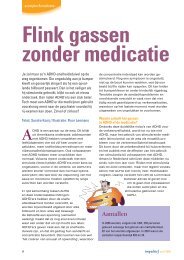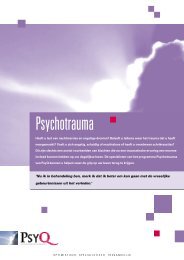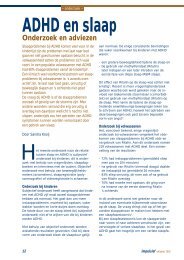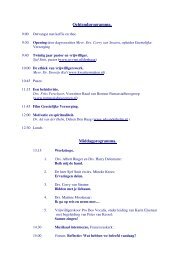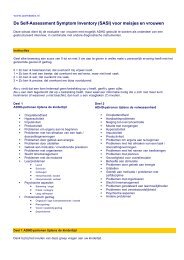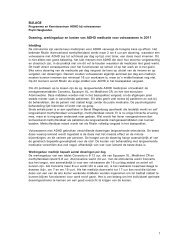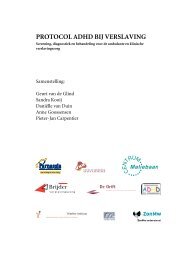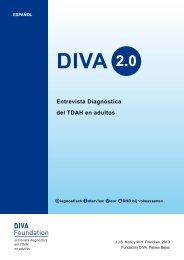Diagnostic Interview for ADHD in adults (DIVA) - PsyQ
Diagnostic Interview for ADHD in adults (DIVA) - PsyQ
Diagnostic Interview for ADHD in adults (DIVA) - PsyQ
You also want an ePaper? Increase the reach of your titles
YUMPU automatically turns print PDFs into web optimized ePapers that Google loves.
Colophon<br />
The <strong>Diagnostic</strong> <strong>Interview</strong> <strong>for</strong><br />
<strong>ADHD</strong> <strong>in</strong> <strong>adults</strong> (<strong>DIVA</strong>) is a<br />
publication of the <strong>DIVA</strong><br />
Foundation, The Hague,<br />
The Netherlands, August<br />
2010. The orig<strong>in</strong>al English<br />
translation by Vertaalbureau<br />
Boot was supported by<br />
Janssen-Cilag B.V. Backtranslation<br />
<strong>in</strong>to Dutch by<br />
Sietske Helder. Revison by<br />
dr. J.J.S. Kooij, <strong>DIVA</strong><br />
Foundation and Prof. Philip<br />
Asherson, Institute of<br />
Psychiatry, London.<br />
Repr<strong>in</strong>ted with permission<br />
from the <strong>Diagnostic</strong> and<br />
Statistical Manual of Mental<br />
Disorders, Text Revision,<br />
Fourth Edition (Copyright<br />
2000). American Psychiatric<br />
Association.<br />
This publication has been<br />
put together with care.<br />
However, over the course of<br />
time, parts of this publication<br />
might change. For that<br />
reason, no rights may be<br />
derived from this publication.<br />
For more <strong>in</strong><strong>for</strong>mation<br />
and future updates of the<br />
<strong>DIVA</strong> please visit<br />
www.divacenter.eu.<br />
Introduction<br />
Accord<strong>in</strong>g to the DSM-IV, ascerta<strong>in</strong><strong>in</strong>g the diagnosis of <strong>ADHD</strong> <strong>in</strong> <strong>adults</strong><br />
<strong>in</strong>volves determ<strong>in</strong><strong>in</strong>g the presence of <strong>ADHD</strong> symptoms dur<strong>in</strong>g both childhood<br />
and adulthood.<br />
The ma<strong>in</strong> requirements <strong>for</strong> the diagnosis are that the onset of <strong>ADHD</strong> symptoms<br />
occurred dur<strong>in</strong>g childhood and that this was followed by a lifelong<br />
persistence of the characteristic symptoms to the time of the current evaluation.<br />
The symptoms need to be associated with significant cl<strong>in</strong>ical or psychosocial<br />
impairments that affect the <strong>in</strong>dividual <strong>in</strong> two or more life situations 1 .<br />
Because <strong>ADHD</strong> <strong>in</strong> <strong>adults</strong> is a lifelong condition that starts <strong>in</strong> childhood, it is<br />
necessary to evaluate the symptoms, course and level of associated impairment<br />
<strong>in</strong> childhood, us<strong>in</strong>g a retrospective <strong>in</strong>terview <strong>for</strong> childhood behaviours.<br />
Whenever possible the <strong>in</strong><strong>for</strong>mation should be gathered from the patient and<br />
supplemented by <strong>in</strong><strong>for</strong>mation from <strong>in</strong><strong>for</strong>mants that knew the person as a child<br />
(usually parents or close relatives) 2 .<br />
The <strong>Diagnostic</strong> <strong>Interview</strong> <strong>for</strong> <strong>ADHD</strong> <strong>in</strong> Adults (<strong>DIVA</strong>)<br />
The <strong>DIVA</strong> is based on the DSM-IV criteria and is the first structured Dutch<br />
<strong>in</strong>terview <strong>for</strong> <strong>ADHD</strong> <strong>in</strong> <strong>adults</strong>. The <strong>DIVA</strong> has been developed by J.J.S. Kooij<br />
and M.H. Francken and is the successor of the earlier Semi-Structured<br />
<strong>Interview</strong> <strong>for</strong> <strong>ADHD</strong> <strong>in</strong> <strong>adults</strong> 2,3 .<br />
In order to simplify the evaluation of each of the 18 symptom criteria <strong>for</strong><br />
<strong>ADHD</strong>, <strong>in</strong> childhood and adulthood, the <strong>in</strong>terview provides a list of concrete<br />
and realistic examples, <strong>for</strong> both current and retrospective (childhood) behaviour.<br />
The examples are based on the common descriptions provided by adult<br />
patients <strong>in</strong> cl<strong>in</strong>ical practice. Examples are also provided of the types of<br />
impairments that are commonly associated with the symptoms <strong>in</strong> five areas of<br />
everyday life: work and education; relationships and family life; social contacts;<br />
free time and hobbies; self-confidence and self-image.<br />
Whenever possible the <strong>DIVA</strong> should be completed with <strong>adults</strong> <strong>in</strong> the presence<br />
of a partner and/or family member, to enable retrospective and collateral<br />
<strong>in</strong><strong>for</strong>mation to be ascerta<strong>in</strong>ed at the same time. The <strong>DIVA</strong> usually takes<br />
around one and a half hours to complete.<br />
The <strong>DIVA</strong> only asks about the core symptoms of <strong>ADHD</strong> required to make the<br />
DSM-IV diagnosis of <strong>ADHD</strong>, and does not ask about other co-occurr<strong>in</strong>g<br />
psychiatric symptoms, syndromes or disorders. However comorbidity is<br />
commonly seen <strong>in</strong> both children and <strong>adults</strong> with <strong>ADHD</strong>, <strong>in</strong> around 75% of<br />
cases. For this reason, it is important to complete a general psychiatric<br />
assessment to enquire about commonly co-occurr<strong>in</strong>g symptoms, syndromes<br />
and disorders. The most common mental health problems that accompany<br />
<strong>ADHD</strong> <strong>in</strong>clude anxiety, depression, bipolar disorder, substance abuse disorders<br />
and addiction, sleep problems and personality disorders, and all these<br />
should be <strong>in</strong>vestigated. This is needed to understand the full range of symptoms<br />
experienced by the <strong>in</strong>dividual with <strong>ADHD</strong>; and also <strong>for</strong> the differential<br />
diagnosis, to exclude other major psychiatric disorders as the primary cause<br />
of ‘<strong>ADHD</strong> symptoms’ <strong>in</strong> <strong>adults</strong> 2 .<br />
2 <strong>DIVA</strong> 2.0 <strong>Diagnostic</strong> <strong>Interview</strong> <strong>for</strong> <strong>ADHD</strong> <strong>in</strong> <strong>adults</strong>



